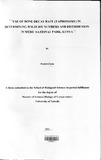| dc.contributor.author | Lala, Fredrick | |
| dc.date.accessioned | 2013-02-27T14:29:53Z | |
| dc.date.issued | 2011 | |
| dc.identifier.citation | Master of Science degree in biology of conservation | en |
| dc.identifier.uri | http://erepository.uonbi.ac.ke:8080/xmlui/handle/123456789/12147 | |
| dc.description.abstract | Bone surveys method was used in Meru national Park to estimate wildlife numbers and their
distribution where bone decay rates were used to estimate the period the animal concern
existed (back-censusing) in the landscape. The results were further compared to previous
aerial wildlife count data to determine the suitability of bone decay rates method as a viable
technique in wildlife counts. Valuable data were generated on wildlife population sizes,
distribution, and species abundance in relation to three main habitats in Meru National Park.
Species diversity was higher in the bone survey (H'=0.723) for the 1990-2002 time bin when
compared to the aerial survey diversity (H' =0.044) for the same period. Similarly diversity
was also higher for the bone survey (H'=1.158) when compared to the live aerial survey (H'=
0.713) for the 2003-2008 time bin. In the grassland there were 14 species encountered using
the bone survey method for the 2003-2008 time bin, which had a higher diversity (H'= 0.93)
compared to the aerial survey which also recorded 14 species (H'= 0.55). In the bushland 12
species were observed using the aerial survey and 16 using the bone survey resulting ill
diversity index values ofH'=0.75 andH'=1.03 respectively.
There was a significant difference (Fl, 27 = 102, P < 0.05) when the densities of the two
surveys were compared, aerial survey had 8 individuals km? while the bones had 4
individuals km". Thickets had the highest diversity (H'=1.09) in terms of the species
encountered using the bone survey with 18 species compared to only 5 that were sampled
using the aerial census (H'=0.52).
The results show that there was a significant relationship between wildlife numbers estimated
using the aerial and the bone method (y=0.7405x - 0.9302, R2 = 0.748) an indication that
taphonomic bone surveys can be used for back-censusing wildlife and estimating their relative
abundance in a given area. The method is inexpensive compared to other wildlife census
methods and can accurately be used to estimate past wildlife population sizes where no past
data previously existed. The result also show that this method is able to capture rare and
elusive species which would be relatively difficult using other methods | en |
| dc.description.sponsorship | University of Nairobi | en |
| dc.language.iso | en | en |
| dc.publisher | University of Nairobi | en |
| dc.subject | bone decay rate (taphonomy) | en |
| dc.subject | wildlife numbers | en |
| dc.subject | wildlife distribution | en |
| dc.subject | Meru National Park | en |
| dc.subject | Kenya | en |
| dc.title | Use of bone decay rate (taphonomy) in determining wildlife numbers anddistribution in Meru National Park, Kenya | en |
| dc.type | Thesis | en |
| local.publisher | School of Biological Sciences | en |

